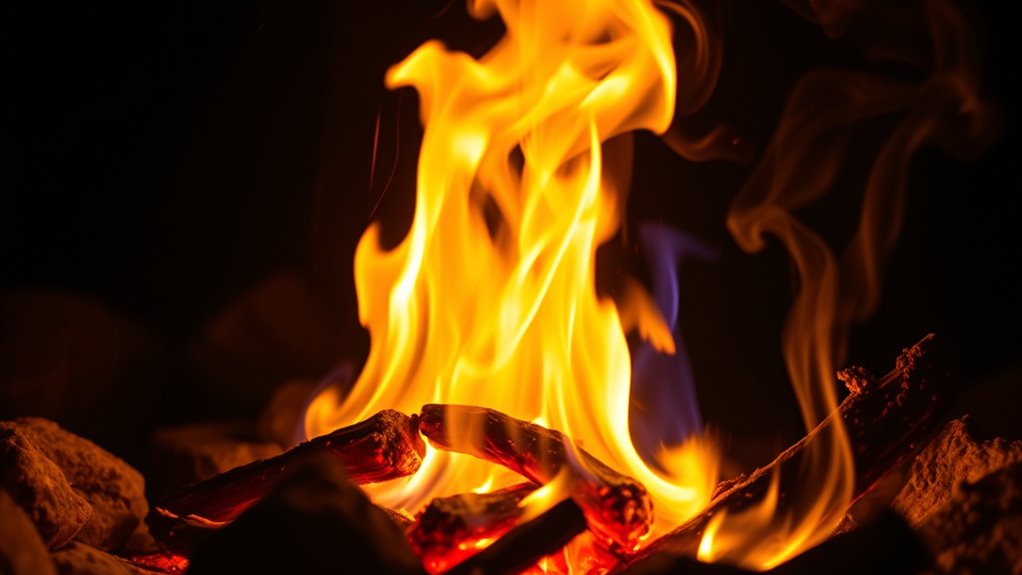Using fire for purification combines deep symbolism with important safety steps. Fire represents transformation, divine connection, and renewal across many cultures. To do it safely, guarantee proper ventilation, keep fire extinguishers nearby, and handle flames carefully with protective tools. Respectful practices also involve choosing safe spaces, avoiding accelerants, and fully extinguishing the fire afterward. If you want to understand how to embrace fire’s spiritual power while staying safe, there’s more to discover below.
Key Takeaways
- Fire symbolizes purification, transformation, and divine connection across cultures, representing renewal and spiritual growth.
- Use proper safety measures like accessible extinguishers, adequate ventilation, and fire-resistant tools during fire rituals.
- Always handle fire with care, never leave unattended, and fully extinguish after use to prevent accidents.
- Respect local regulations and environmental conditions, obtaining permits when necessary for safe fire practices.
- Visualize and focus intentions during fire ceremonies to enhance spiritual cleansing and personal transformation.
The Historical Significance of Fire in Rituals

Throughout history, fire has played a crucial role in rituals as a symbol of purification, transformation, and divine presence. You can see its significance across cultures—from ancient Egypt to Native American ceremonies—where fire represented a bridge between the earthly and spiritual spheres. Many societies believed fire possessed the power to cleanse sins, spirits, and negative energies, making it central to rites of passage, sacrifices, and renewal ceremonies. Fire’s transformative power was seen as a way to forge new beginnings or communicate with deities. Its flickering flames embodied the divine, offering a tangible connection to higher powers. The importance of fire in rituals continues to be studied and appreciated today, highlighting its symbolic significance in spiritual practices worldwide. Over time, fire’s role in rituals has persisted, symbolizing the enduring human desire for renewal, enlightenment, and spiritual evolution.
Understanding Fire’s Role in Spiritual Cleansing

Fire’s symbolic power extends beyond its role in rituals; it is often seen as a tool for spiritual cleansing. When you engage with fire intentionally, you’re believed to release negative energies, purify your mind, and foster renewal. The process involves focusing your intentions on letting go of emotional burdens or past mistakes, allowing the flames to symbolize transformation. Many cultures see fire as a catalyst that clears away spiritual impurities, making room for growth and clarity. As you watch the flames consume, it can serve as a meditative act, helping you visualize the shedding of old patterns. Understanding asset division laws and the importance of proper documentation can help ensure your spiritual and emotional healing is supported by practical steps. This understanding reinforces fire’s significance as a purifier, not just physically but also on a deeper, spiritual level, guiding you toward inner harmony.
Practical Uses of Fire for Purification in Daily Life
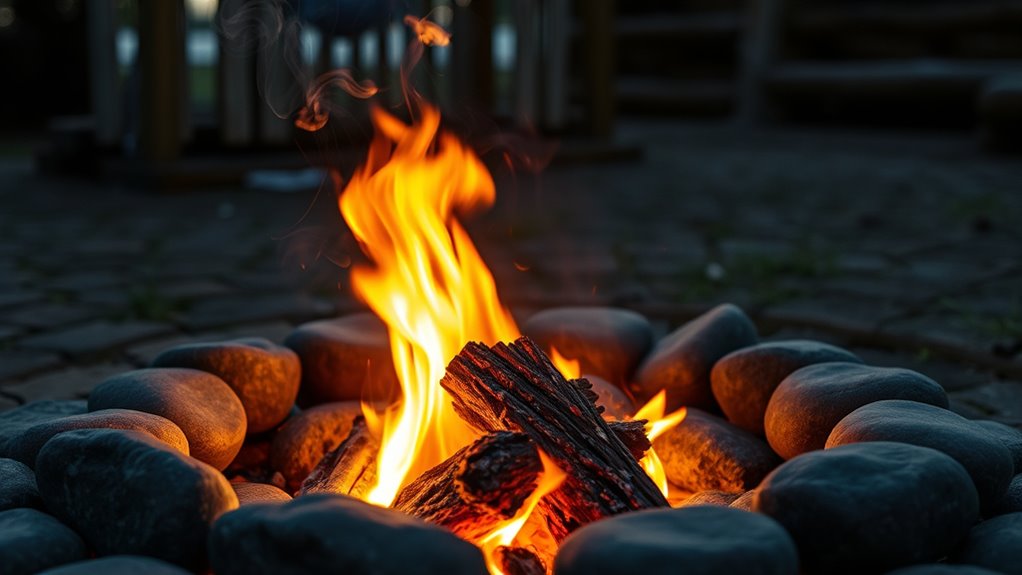
You can use fire-based methods like flame sterilization to keep your kitchen tools clean and safe. Personal rituals, such as passing objects through a flame, help purify and remove negative energy. Additionally, you might employ controlled burning or smudging to disinfect your living space effectively. Understanding the fire safety principles is essential to prevent accidents and ensure proper purification.
Kitchen Sanitization Techniques
Using fire for kitchen sanitization is an effective way to eliminate germs and bacteria from utensils and surfaces. You can use a flame to quickly burn away residue on metal tools or to sterilize knives by passing them through a flame briefly. For cookware and cutting boards, flaming can help reduce contamination, especially after chopping raw meat or produce. Always confirm the item is heat-resistant and hold it securely to avoid accidents. Using a flame also helps sanitize utensils that are difficult to wash thoroughly, like skewers or metal tongs. Remember to exercise caution and keep flammable objects away. This method offers a quick, chemical-free way to disinfect your kitchen, reducing the risk of foodborne illnesses and keeping your space safe. Additionally, incorporating proper safety precautions when using fire ensures a safe and effective sanitization process.
Personal Ritual Cleansing
In many cultures, lighting a small flame or candle is a simple yet powerful way to purify the mind and spirit during personal rituals. You can use this act to symbolize releasing negative energy and welcoming clarity. As you light the candle, focus on your intentions—whether it’s cleansing emotional burdens or starting fresh. The gentle flame acts as a reminder to stay present, grounding your thoughts. You might recite a prayer, affirmation, or simply breathe deeply, allowing the fire’s warmth to enhance your focus. Afterward, let the candle burn safely until it’s finished, symbolizing the completion of your cleansing process. Personal ritual cleansing with fire helps you create a moment of mindfulness, fostering emotional renewal and spiritual clarity. The symbolism of fire as a purification tool is rooted in many cultural traditions that emphasize transformation and renewal.
Home Disinfection Methods
Fire has long been recognized as an effective tool for disinfecting and purifying your living space. You can use methods like burning sage, incense, or herbs to cleanse the air and eliminate lingering germs. Lighting candles or small fires in a controlled manner helps sanitize surfaces and reduce bacteria. Smudging with sage or palo santo is a traditional practice that clears negative energy while disinfecting. When using fire for home disinfection, ensure proper ventilation and safety precautions to prevent accidents. Keep fires contained and never leave them unattended. Combining fire-based rituals with regular cleaning enhances your home’s hygiene and spiritual ambiance. These practices harness fire’s purifying power, creating a healthier, more harmonious environment in your daily life. Incorporating artistic expression into your routines can also promote mental well-being and resilience, enriching your overall approach to home purification.
Essential Fire Safety Measures and Precautions
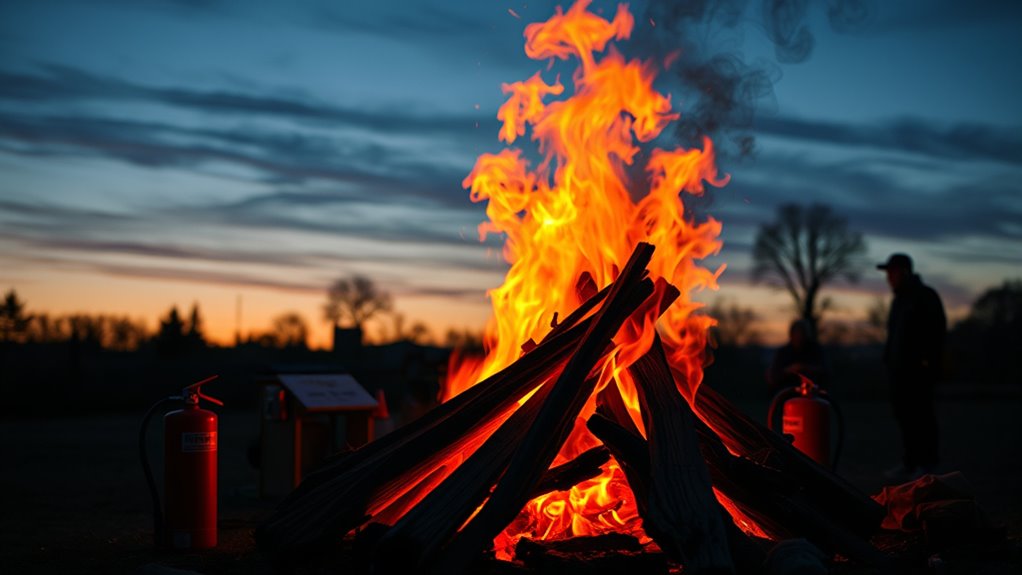
To keep yourself safe while using fire for purification, you need to follow essential safety measures. Make sure fire extinguishers are strategically placed and easily accessible, and always use proper ventilation techniques to prevent smoke buildup. Additionally, handle fire sources carefully and responsibly to reduce the risk of accidents or injuries. Being aware of your surroundings and understanding the fire safety procedures can further enhance your protection during these activities.
Fire Extinguisher Placement
Have you ever wondered if your fire extinguishers are positioned for quick access during an emergency? Proper placement is vital for effective fire safety. You should mount extinguishers on visible, easily accessible walls near potential fire sources like kitchens, workshops, or electrical rooms. Keep them at a height where you can grab them quickly, typically between 3.5 and 5 feet from the ground. Avoid placing extinguishers behind doors, behind furniture, or in cluttered areas that could delay your response. Confirm they are not blocked by obstacles and are in locations everyone can reach easily. Regularly check that extinguishers are mounted securely and visible. Proper placement ensures you can respond swiftly, minimizing fire damage and protecting lives. Additionally, understanding fire safety measures helps ensure comprehensive preparedness in case of emergencies.
Proper Ventilation Techniques
Did you know that proper ventilation plays an essential role in preventing the spread of smoke and toxic fumes during a fire? To guarantee safety, you should:
- Open windows and doors on opposite sides to create a cross-breeze, helping smoke exit quickly.
- Use exhaust fans or vents to draw out contaminated air and improve airflow.
- Keep ventilation pathways clear of obstructions to maintain steady air circulation.
- Monitor airflow direction to avoid pulling smoke into other areas, reducing inhalation risks.
- Be aware of entertainment and parks operating hours to plan safe evacuation routes in case of an emergency.
Safe Handling Practices
Ensuring safe handling practices is crucial for preventing injuries and minimizing fire risks during a fire. Always keep a fire extinguisher nearby and know how to use it. Maintain a clear area around the fire, free of flammable materials. Never leave the fire unattended, and keep water or a fire blanket close at hand. Use fire-resistant gloves and tools to handle burning materials safely. Proper fire safety measures include regularly inspecting equipment and staying aware of your surroundings.
Common Mistakes to Avoid During Fire Rituals

One common mistake during fire rituals is neglecting proper safety precautions, which can lead to accidents or unintended damage. To avoid this, keep these points in mind:
- Ignoring fire boundaries — always set clear limits to prevent the fire from spreading.
- Overloading the fire with materials — use only appropriate offerings to maintain control.
- Neglecting ventilation — ensure proper airflow to prevent smoke buildup.
- Leaving the fire unattended — never leave it burning unsupervised, especially in combustible environments.
Cultural Variations in Fire-Based Purification Practices

Across different cultures, fire-based purification practices vary considerably, reflecting unique spiritual beliefs and traditional customs. In some societies, fire symbolizes cleansing and renewal, while others see it as a protective force. For example, in Japan, burning offerings during funeral rites signifies releasing spirits. Conversely, Native American tribes use sacred fires to connect with nature and purify the soul.
| Culture | Practice Description | Significance |
|---|---|---|
| Japan | Burning incense and offerings during rituals | Spiritual cleansing and respect |
| Native Americans | Sacred fires for ceremonies and purification | Connection with nature, renewal |
| India | Holika Dahan bonfires during Holi | Overcoming evil, renewal |
Symbolism of Fire in Different Traditions
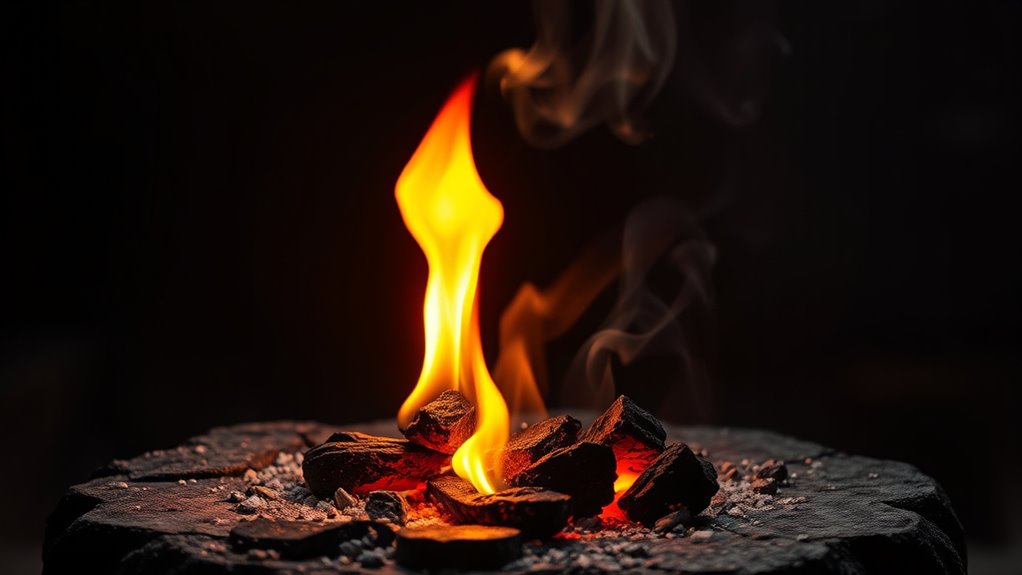
Fire holds powerful symbolic meanings in many traditions, representing more than just physical flames. It often signifies transformation, renewal, and divine presence. In Hinduism, fire embodies Agni, a messenger between humans and gods, symbolizing purity and spiritual insight. In Christianity, fire represents the Holy Spirit, cleansing sins and inspiring faith. Native American cultures see fire as a sacred connector to ancestors and nature. Similarly, in ancient Greece, fire signified purification and the eternal flame of knowledge. Recognizing these symbols helps you appreciate fire’s deeper significance:
Fire symbolizes transformation, purification, divine presence, and renewal across many spiritual and cultural traditions.
- Transformation – changing states or spiritual growth
- Purification – cleansing impurities and sins
- Divine presence – connection with higher powers
- Renewal – rebirth and new beginnings
Understanding these meanings enriches your respect and mindful use of fire.
Tips for Respectful and Safe Fire Use
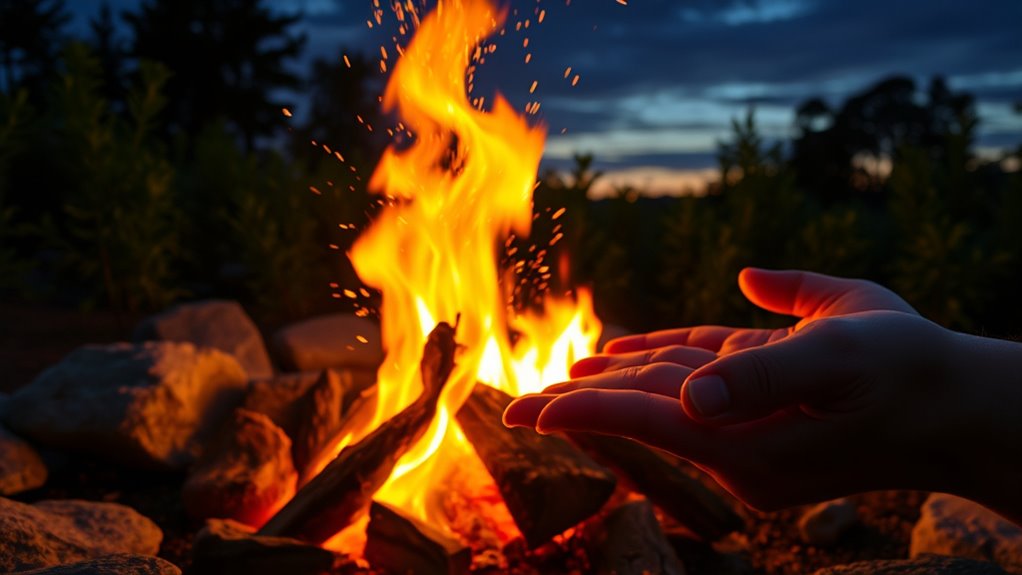
To guarantee fire remains a safe and respectful tool, it’s essential to follow proper precautions and practices. Always keep a fire extinguisher or water nearby when you light a fire, and never leave it unattended. Choose a clear, open space away from flammable materials, structures, and vegetation. Use a safe ignition method, like matches or a lighter, rather than accelerants that can cause uncontrolled flames. When extinguishing the fire, ensure it’s fully out by dousing it with water and stirring the ashes until cool. Respect local regulations and obtain permits if required. Be mindful of wind conditions that could spread sparks. By practicing these safety tips, you honor fire’s power while preventing accidents and respecting its symbolism.
Frequently Asked Questions
How Do Different Cultures Interpret Fire’s Purifying Power Symbolically?
Different cultures see fire’s purifying power as a symbol of renewal and transformation. In many traditions, fire cleanses evil or negativity, clearing the way for new beginnings. For example, Native Americans use fire in ceremonies to purify spirits, while in Hinduism, fire represents divine energy and spiritual awakening. You might notice fire’s symbolic role in rituals and festivals, emphasizing its power to purify, renew, and inspire spiritual growth across diverse cultures.
Can Fire Purification Rituals Be Safely Adapted for Modern Indoor Environments?
Absolutely, you can adapt fire purification rituals for modern indoor spaces, but you must respect safety boundaries like a guardian of flames. Use flameless candles or safe incense instead of open fires, and guarantee proper ventilation. Never leave burning objects unattended, and keep fire extinguishers nearby. By blending ancient symbolism with modern safety, you create a powerful, transformative experience without risking your space or well-being.
Are There Specific Materials That Should or Shouldn’T Be Burned During Purification?
You should avoid burning plastics, synthetic materials, or anything chemical, as they release harmful fumes. Stick to natural items like herbs, resins, or wood that are intended for purification rituals. These materials burn cleanly and safely, helping you focus on the spiritual aspect without risking health. Always make certain of proper ventilation and use fire-safe containers to prevent accidents, making your purification process both meaningful and safe.
How Does One Spiritually Prepare Before Performing a Fire Cleansing Ritual?
Think of your spirit as a garden awaiting renewal. Before a fire cleansing, clear your mind and set a strong intention, like planting seeds of growth. Meditate or breathe deeply to center yourself, imagine the fire as a purifier that burns away negativity. Focus on your purpose, and visualize positivity blossoming afterward. This mental preparation helps you connect deeply with the ritual’s transformative power.
What Are the Psychological Benefits of Participating in Fire-Based Purification Practices?
Participating in fire-based purification practices can boost your mental clarity and reduce stress by symbolically releasing negative thoughts and emotions. You may feel a sense of renewal and empowerment as you engage in the ritual, helping you gain perspective and emotional strength. The fiery element energizes your mind, encouraging mindfulness and focus. Ultimately, these practices can foster a deeper connection to yourself and promote psychological resilience.
Conclusion
By respecting fire’s power, embracing its symbolism, and practicing safety, you honor its role in purification. You acknowledge fire’s ancient significance, you harness its cleansing energy, and you safeguard yourself and others. You learn from traditions past, adapt with mindfulness today, and carry forward the sacred trust of fire’s transformative force. With awareness and reverence, you guarantee that fire remains a symbol of renewal, a tool for purification, and a guardian of safety in your life.
